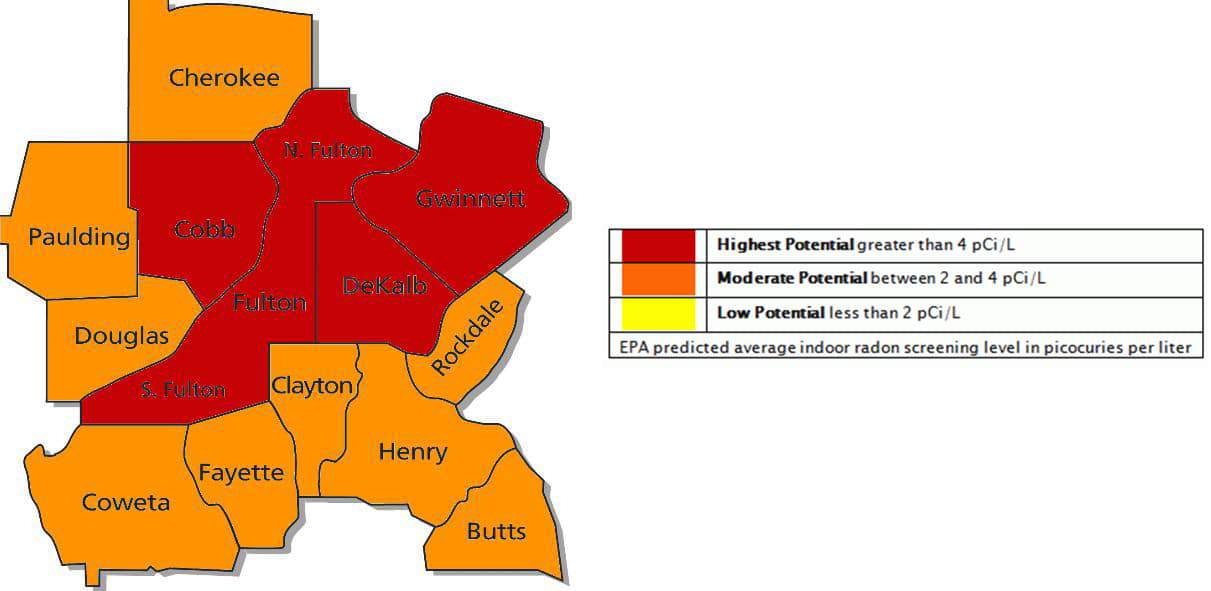Radon Testing & Mitigation
Sounds Dangerous, what exactly is it?
The gas is a carcinogenic, radioactive gas that is produced from the breakdown of Uranium in the earth’s crust. Because the gas is odorless and invisible, many homeowners don’t even realize that their home could have dangerously high levels of the gas.
Radon is a natural byproduct of the breakdown of uranium, and in the family of radioactive noble gases which will not combine with any other elements. Therefore, the gas escapes from the earth fully intact. Because of the way the gas reacts with the environment and breaks down, the more of the gas that enters your home, the more radioactive bi-products your family will have. The decay cycle will always continue, creating more and more radioactive byproducts.
Contact Healthy Air USA today if you think there may be dangerous levels of the gas in your home so we can assist you in the appropriate manner. View our service area here.
Where Does the Gas Come From?
The gas comes from the soil. When uranium decays, it breaks down into radium. As radium disintegrates, it turns into a gas.
The gas travels through the soil intact to the ground’s surface. The substructure of homes draws the Radon through the cracks and openings and into the house. It is generally found in basements and other underground areas that are surrounded by soil or rock. The gas is able to get into these areas by coming in through cracks or openings.
Some causes of the suction in your home include:
- Warm air rising inside your home
- Wind blowing past your home
- Air used by fireplaces, wood stoves, furnaces, and other heating elements
- Air vented to the outside by clothes dryers and exhaust fans in bathrooms or kitchens
The gas may also enter your home through the walls as well as openings in your home including dirt floor crawl space areas, unsealed sump pumps, and cracks in concrete floors.
It is highly radioactive, and once it enters your home, it can lead to serious health complications–even cancer.
Metro Atlanta Levels

National Levels
Based on an EPA national residential survey completed the average indoor level is about 1.3 picocuries per liter (pCi/L) in air in the United States. The average outdoor level is about 0.4 pCi/L. The EPA recommends homes be mitigated if the gas level is 4 pCi/L (picocuries per liter) or more
What are the Health Risks of the Gas?
The Environmental Protection Agency (EPA) estimates that 21,000 people die of exposure every year in the United States. In 1988, the EPA classified radon as a carcinogen.
It is the number one cause of lung cancer among non-smokers, according to EPA estimates. A smoker who is also exposed to the gas has a much higher risk of lung cancer. Lung cancer now surpasses breast cancer as the number one cause of death among women.
High levels of radon can lead to lung cancer when it’s in the air, and stomach cancer when it’s ingested from contaminated water.
Based on a National Academy of Sciences report on the gas in drinking water, EPA estimates that radon in drinking water causes about 168 cancer deaths per year, 89 percent from lung cancer caused by breathing the gas released from water, and 11 percent from stomach cancer caused by drinking radon-containing water.
How Do I Know if I Have High Levels of the Gas in My Home?
The Environmental Protection Agency recommends that all homes be tested for radon and also recommends that all homes which have airborne levels that are greater than 4.0pCi/L or greater have mitigation services completed.
The average concentration in the indoor air of America’s homes is about 1.3 pCi/L. The average concentration of the gas in outdoor air is 0.4 pCi/L or 1/10th of EPA’s 4.0 pCi/L action level.
The EPA recommends homes be mitigated if the level is 4.0 pCi/L (picocuries per liter) or more.
Because there is no known safe level of exposure to the gas, EPA also recommends that Americans consider fixing their home for levels between 2.0 pCi/L and 4.0 pCi/L. It is upon this level that EPA based its estimate of 20,000 Radon-related lung cancers a year.
If your home tests higher than 4.0pCi/L you should consider mitigation options to reduce high indoor levels of radon.
